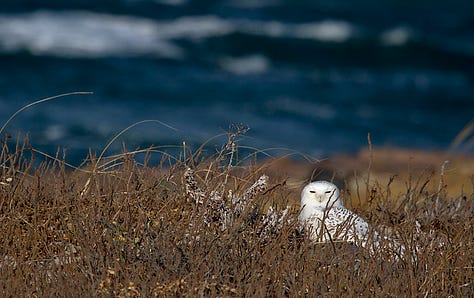Arctic Owls on a Warming Planet
When they come to us in winter, Snowy Owls are honest messengers from an Arctic that most of us will never visit. (The inaugural post on Chasing Nature.)
Perched on a rocky point along the coast of Maine, the Snowy Owl is languid, indifferent, a predator without country. The wind and cold and crashing waves do not matter. You do not matter. The Snowy Owl cares not that you have driven halfway across winter to witness a white bird alone on the headlands.
So as you peer through binoculars and watery eyes at a creature from a place wilder and colder than Maine, the owl fixes its gaze out to sea, where it might snatch a duck from the waves for a meal. But then you curse the wind chill or stomp your frozen feet. The owl spins its head your way.
From a Snowy Owl’s eyes the Arctic speaks. Hypnotic and seductive, like bioluminescence or romance, the glow brings you immediate pleasure. From the intensity of this gaze you cannot look away. And yet from the owl there is no reciprocity.
The Snowy Owl is not like you or me. It has no interest in killing and eating you. And even if it suspects that you yourself might want to kill and eat it, the owl decides that you are, for the time being, standing at a safe distance. So it is done with you. And in that moment before it turns its gaze back toward the sea, back to its thoughts and desires, the Snowy Owl sends you a message: “Go about your business. I’ve got mice and voles and ducks to kill here. Go lead your quiet life.”
SNOWY OWLS breed in some of the coldest places on earth, a circumpolar zone that spans Siberia, Greenland, Canada and Alaska. For the most part, during winter, Snowy Owls generally do not move much farther south than their breeding grounds. But every winter some of them indeed fly toward us — sometimes they come in big numbers.
Snowy Owls in winter can show up beyond the lighthouses and rocky shores of Maine and other northern tier states — to the monuments of Washington, D.C., to a Discount Tire franchise in Odessa, Texas, and even to a dockyard in Bermuda. For bundled-up (or bathing-suited) birdwatchers, these owl movements can be among a winter’s great and most puzzling natural events.
People often ask me why the Snowy Owls come, whether something has gone wrong in the Arctic. Birdwatchers worry that the owls are turning up emaciated and in distress. Environmentalists point to climate upheaval as a cause. Sometimes all of that is true — sometimes none of it.



As it turns out, there is nothing unusual about Snowy Owls moving south in winter — at least not yet. Like other predators, Snowy Owl numbers can be cyclical and linked to the abundance of prey — mostly lemmings and other small mammals on the breeding grounds. Conventional wisdom holds that when lemmings undergo a population crash, Snowy Owls move south in search of replacement rodents.
But the owls also move south during periods of lemming abundance in the Arctic. Lots of prey on the breeding grounds means more young owls fledge with the resources to survive their first perilous months of independence. By early winter, particularly if the lemmings happen to crash or the adult owls claim better winter feeding areas, surviving youngsters wander south for food. At least that’s the hypothesis — a fairly good one. A large proportion of the owls visiting the U.S. in winter are indeed immature birds on their first journey.
Whatever the case, in an owl’s journey I find much more than the visceral pleasure of an iconic white bird. When they come, Snowy Owls are honest messengers from a warming Arctic that most of us will never visit.
To be sure, the Earth is now smaller and more accessible than ever. From the comfort of our glowing screens we navigate the high peaks of the Himalaya, lumber among elephants across the Serengeti and float the Colorado River beneath the Grand Canyon’s pastel walls. How odd that now, during the planet’s latest mass extinction, we have a new age of mass experience and distraction online.
The cinematic, of course, is no substitute for the real thing — or for what’s left of it. And yet no sea turtles or Parrotfish will ever leave the Great Barrier Reef to visit the Northeast and remind us of the biodiversity we’re losing from the coral reefs. No American Bison or Regal Fritillary butterfly will wander to the farms, subdivisions and strip malls that destroyed most of American tallgrass prairies. And from the Arctic, no Beluga Whale or Polar Bear will leave its frigid waters or ice for our neighborhoods or lakeshores.
But the Snowy Owls come instead.
In the lemony glow of their eyes, I see a land where trees do not exist, where orchids glow like little purple flames among heather and rock and lichen, where the sun might never rise or never set, and where the Snowy Owl has never seen the likes of fossil fuel companies, governments and the earth’s wealthiest people, collectively with an outsized role in global overheating.
The owls and us, at the dawn of the day we are predators alike — and with a shared irony. When they visit, Snowy Owls make the natural world smaller, more worthy of discovery, enjoyment and protection. And they come to us even as Big Carbon makes the Arctic warmer and diminished, and renders humanity less worthy of what the owls themselves represent.
Postscript: A version of this essay, sans the climate angle, appeared in Aeon magazine.





looking forward to your showing us where to see these birds. Thank you. Also, do you bill us when it's time for us to renew? Don't want to miss a thing! Thank you. Jo
I gladly shared.